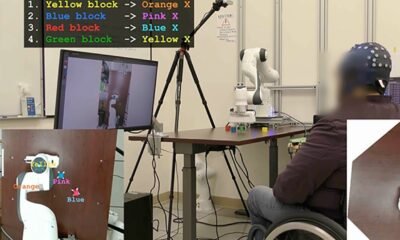AI Research
Thinking Machines named OpenAI’s first APAC partner

Thinking Machines Data Science is joining forces with OpenAI to help more businesses across Asia Pacific turn artificial intelligence into measurable results. The collaboration makes Thinking Machines the first official Services Partner for OpenAI in the region.
The partnership comes as AI adoption in APAC continues to rise. An IBM study found that 61% of enterprises already use AI, yet many struggle to move beyond pilot projects and deliver real business impact. Thinking Machines and OpenAI aim to change that by offering executive training on ChatGPT Enterprise, support for building custom AI applications, and guidance on embedding AI into everyday operations.
Stephanie Sy, Founder and CEO of Thinking Machines, framed the partnership around capability building: “We’re not just bringing in new technology but we’re helping organisations build the skills, strategies, and support systems they need to take advantage of AI. For us, it’s about reinventing the future of work through human-AI collaboration and making AI truly work for people across the Asia Pacific region.”
Turning AI pilots into results with Thinking Machines
In an interview with AI News, Sy explained that one of the biggest hurdles for enterprises is how they frame AI adoption. Too often, organisations see it as a technology acquisition rather than a business transformation. That approach leads to pilots that stall or fail to scale.
“The main challenge is that many organisations approach AI as a technology acquisition rather than a business transformation,” she said. “This leads to pilots that never scale because three fundamentals are missing: clear leadership alignment on the value to create, redesign of workflows to embed AI into how work gets done, and investment in workforce skills to ensure adoption. Get those three right—vision, process, people—and pilots scale into impact.”
Leadership at the centre
Many executives still treat AI as a technical project rather than a strategic priority. Sy believes that boards and C-suites need to set the tone. Their role is to decide whether AI is a growth driver or just a managed risk.
“Boards and C-suites set the tone: Is AI a strategic growth driver or a managed risk? Their role is to name a few priority outcomes, define risk appetite, and assign clear ownership,” she said. Thinking Machines often begins with executive sessions where leaders can explore where tools like ChatGPT add value, how to govern them, and when to scale. “That top-down clarity is what turns AI from an experiment into an enterprise capability.”
Human-AI collaboration in practice
Sy often talks about “reinventing the future of work through human-AI collaboration.” She explained what this looks like in practice: a “human-in-command” approach where people focus on judgment, decision-making, and exceptions, while AI handles routine steps like retrieval, drafting, or summarising.
“Human-in-command means redesigning work so people focus on judgment and exceptions, while AI takes on retrieval, drafting, and routine steps, with transparency through audit trails and source links,” she said. The results are measured in time saved and quality improvements.
In workshops run by Thinking Machines, professionals using ChatGPT often free up one to two hours per day. Research supports these outcomes—Sy pointed to an MIT study showing a 14% productivity boost for contact centre agents, with the biggest gains seen among less-experienced staff. “That’s clear evidence AI can elevate human talent rather than displace it,” she added.
Agentic AI with Thinking Machines’ guardrails
Another area of focus for Thinking Machines is agentic AI, which goes beyond single queries to handle multi-step processes. Instead of just answering a question, agentic systems can manage research, fill forms, and make API calls, coordinating entire workflows with a human still in charge.
“Agentic systems can take work from ‘ask-and-answer’ to multi-step execution: coordinating research, browsing, form-filling, and API calls so teams ship faster with a human in command,” Sy said. The promise is faster execution and productivity, but the risks are real. “The principles of human-in-command and auditability remain critical; to avoid the lack of proper guardrails. Our approach is to pair enterprise controls and auditability with agent capabilities to ensure actions are traceable, reversible, and policy-aligned before we scale.”
Governance that builds trust
While adoption is accelerating, governance often lags behind. Sy cautioned that governance fails when it’s treated as paperwork instead of part of daily work.
“We keep humans in command and make governance visible in daily work: use approved data sources, enforce role-based access, maintain audit trails, and require human decision points for sensitive actions,” she explained. Thinking Machines also applies what it calls “control + reliability”: restricting retrieval to trusted content and returning answers with citations. Workflows are then adapted to local rules in sectors such as finance, government, and healthcare.
For Sy, success isn’t measured in the volume of policies but in auditability and exception rates. “Good governance accelerates adoption because teams trust what they ship,” she said.
Local context, regional scale
Asia Pacific’s cultural and linguistic diversity poses unique challenges for scaling AI. A one-size-fits-all model doesn’t work. Sy emphasised that the right playbook is to build locally first and then scale deliberately.
“Global templates fail when they ignore how local teams work. The playbook is build locally, scale deliberately: fit the AI to local language, forms, policies, and escalation paths; then standardise the parts that travel such as your governance pattern, data connectors, and impact metrics,” she said.
That’s the approach Thinking Machines has taken in Singapore, the Philippines, and Thailand—prove value with local teams first, then roll out region by region. The aim is not a uniform chatbot but a reliable pattern that respects local context while maintaining scalability.
Skills over tools
When asked what skills will matter most in an AI-enabled workplace, Sy pointed out that scale comes from skills, not just tools. She broke this down into three categories:
- Executive literacy: the ability for leaders to set outcomes and guardrails, and know when and where to scale AI.
- Workflow design: the redesign of human-AI handoffs, clarifying who drafts, who approves, and how exceptions escalate.
- Hands-on skills: prompting, evaluation, and retrieval from trusted sources so answers are verifiable, not just plausible.
“When leaders and teams share that foundation, adoption moves from experimenting to repeatable, production-level results,” she said. In Thinking Machines’ programs, many professionals report saving one to two hours per day after just a one-day workshop. To date, more than 10,000 people across roles have been trained, and Sy noted the pattern is consistent: “skills + governance unlock scale.”
Industry transformation ahead
Looking to the next five years, Sy sees AI shifting from drafting to full execution in critical business functions. She expects major gains in software development, marketing, service operations, and supply chain management.
“For the next wave, we see three concrete patterns: policy-aware assistants in finance, supply chain copilots in manufacturing, and personalised yet compliant CX in retail—each built with human checkpoints and verifiable sources so leaders can scale with confidence,” she said.
A practical example is a system Thinking Machines built with the Bank of the Philippine Islands. Called BEAi, it’s a retrieval-augmented generation (RAG) system that supports English, Filipino, and Taglish. It returns answers linked to sources with page numbers and understands policy supersession, turning complex policy documents into everyday guidance for staff. “That’s what ‘AI-native’ looks like in practice,” Sy said.
Thinking Machines expands AI across APAC
The partnership with OpenAI will start with programs in Singapore, the Philippines, and Thailand through Thinking Machines’ regional offices before expanding further across APAC. Future plans include tailoring services to sectors such as finance, retail, and manufacturing, where AI can address specific challenges and open new opportunities.
For Sy, the goal is clear: “AI adoption isn’t just about experimenting with new tools. It’s about building the vision, processes, and skills that let organisations move from pilots to impact. When leaders, teams, and technology come together, that’s when AI delivers lasting value.”
See also: X and xAI sue Apple and OpenAI over AI monopoly claims

Want to learn more about AI and big data from industry leaders? Check out AI & Big Data Expo taking place in Amsterdam, California, and London. The comprehensive event is part of TechEx and is co-located with other leading technology events, click here for more information.
AI News is powered by TechForge Media. Explore other upcoming enterprise technology events and webinars here.
AI Research
Achieving the Next Era of Intelligence
AGI: the timeline, breakthroughs needed, why AI models are falling short and a practical path forward.
Explore how industry leaders are defining artificial general intelligence (AGI) and what it may take to reach it. Developed by MIT Technology Review and Arm, this deep dive examines accelerating timelines, the compute innovations shaping progress, and why today’s models still fall short of true intelligence. Designed for engineers, researchers, and technology leaders navigating the future of AI.
Key Takeaways
- AGI timelines are accelerating: Experts predict early AGI traits by 2026; 50% chance of full AGI by 2047.
- AGI demands a smarter compute strategy: Achieving intelligence at scale will require more efficient architectures, new system design approaches, and intelligent orchestration.
- Today’s AI isn’t truly intelligent: At publication, models lack reasoning, adaptability, and understanding.
- Benchmarks must improve: Metrics like fluid and social intelligence better reflect AGI goals.
- Scale isn’t everything: AGI requires new architectures and approaches, not just more compute.
Read more here.
AI Research
Marquis Who’s Who Honors Sandra E. Cheung, PhD, for Expertise in Artificial Intelligence

Marquis Who’s Who Honors Sandra E. Cheung, PhD, for Expertise in Artificial Intelligence
Sandra E. Cheung promotes AI literacy and drives technology transformations
She aims to cultivate artificial intelligence literacy among communities across the United States by planting seeds of knowledge that encourage individuals to manage future technology challenges.
BELMONT, CA, September 10, 2025 /24-7PressRelease/ — Sandra E. Cheung, PhD, has been included in Marquis Who’s Who. As in all Marquis Who’s Who biographical volumes, individuals profiled are selected on the basis of current reference value. Factors such as position, noteworthy accomplishments, visibility, and prominence in a field are all taken into account during the selection process.
Dr. Cheung is a distinguished leader in the technology and engineering sectors. Inspired by the emergence of artificial intelligence in the technology sector, she launched AImpowered in 2025, and the nonprofit organization has since been dedicated to educating people on safe and effective use of AI. As the chief executive officer of the firm, she has been instrumental in shaping the organization’s mission to bridge the digital divide and promote AI literacy, and she manages project timelines, coordinates meetings, implements key strategies, and monitors performance. Dr. Cheung also oversees budget expenditures, ensures compliance, and expertly supports her associates in their innovative pursuits.
Through AImpowered, Dr. Cheung offers workshops tailored for both children and adults, emphasizing the importance of in-person interactions for those affected by technological barriers. She is particularly dedicated to supporting individuals who struggle with technology, equipping them with the necessary tools to navigate the evolving landscape of AI. Dr. Cheung is also proud to curate content that helps parents gauge the influence of AI on home and school environments and to promote advocacy for children’s education in this field.
Drawing from her own experiences raising children during the rise of mobile phones, Dr. Cheung aids parents in grasping contemporary challenges posed by rapid technological advancement. Additionally, she prioritizes platforms that empower current technology workers to harness AI in their work. Notably, Dr. Cheung’s efforts through AImpowered prepare both parents and professionals to thrive in an increasingly AI-driven world.
In her comprehensive role, Dr. Cheung relies on experience gained from a series of pivotal professional appointments. From 2021 to 2024, she was the chief of staff and head of operations, strategy and planning at Webex, where she held oversight of operational efficiency and strategic initiatives that supported the company’s growth in collaborative technologies. Between 2018 and 2020, Dr. Cheung excelled as the director of software engineering at Cisco, and her signature leadership was pivotal in driving software development projects that enhanced Cisco’s product offerings.
From 2012 to 2018, Dr. Cheung provided technology and management consulting services at Cadushi, advising organizations on optimizing their technological infrastructure and management practices. Additionally, during her tenure as the senior director of infrastructure engineering and production operations at Yahoo! from 2005 to 2012, she played a critical role in addressing a significant crisis related to data center capacity amid financial constraints. Drawing inspiration from Yahoo!’s engineers, she collaborated with leadership to drive innovation among the company’s teams, inspiring others to look beyond conventional methods and galvanizing teams around a shared vision.
Before joining Yahoo!, Dr. Cheung was the director of network planning, design and analysis at Covad from 2003 to 2005, before which she served as the director of network engineering at Covad Communications from 1998 to 2003. In these positions, she oversaw network infrastructure development and strategic planning. Dr. Cheung began her professional journey in 1994 as a senior member of technical staff at AT&T, where she thrived through 1998.
The pursuit of service opportunities prompted Dr. Cheung to accept an appointment as the co-chair of the engineering council at Founders Creative in 2025, through which she contributes her expertise to foster innovation within the organization. Her commitment to promoting and advancing women in various fields is reflected through her membership in Women in Collaboration and her substantial leadership tenure with the Girl Scouts; additionally, Dr. Cheung is a proud co-founder and the acting president of the Silicon Valley Ice Skating Association.
Dr. Cheung’s academic credentials are impressive and include a Bachelor of Science in computer science from Florida Institute of Technology, which she completed in 1988. She also holds a Doctor of Philosophy in computer science from the University of Florida, which she proudly earned in 1993. Dr. Cheung credits her adaptability and dedication to making a positive impact on others as central to her success across diverse personal and professional platforms.
Looking toward the future, Dr. Cheung aims to cultivate artificial intelligence literacy among communities across the United States by planting seeds of knowledge that encourage individuals to manage future technology challenges. She emphasizes education as a foundation that must extend throughout all stages of learning so that younger generations can navigate change without anxiety while remaining grounded in core human values. Through her initiatives, Dr. Cheung seeks to foster collaboration and help people embrace transformative advancements.
About Marquis Who’s Who®:
Since 1899, when A. N. Marquis printed the First Edition of Who’s Who in America®, Marquis Who’s Who® has chronicled the lives of the most accomplished individuals and innovators from every significant field of endeavor, including politics, business, medicine, law, education, art, religion and entertainment. Who’s Who in America® remains an essential biographical source for thousands of researchers, journalists, librarians and executive search firms around the world. The suite of Marquis® publications can be viewed at the official Marquis Who’s Who® website, www.marquiswhoswho.com.
# # #
AI Research
LLMs: AI Psychosis Research Lab

There is a new [September 5, 2025] paper review in Scientific American, How the Brain Tells Imagination from Reality, stating that, “Picture an apple, any apple. As long as you don’t have aphantasia—the inability to visualize things in your mind’s eye—this suggestion triggers brain activity that’s surprisingly similar to what happens when you see a real-world apple with your eyes. Such neural overlap is economical because both cases require the brain’s visual system to carry out many of the same tasks. But it also raises a question: How does our brain tell reality and imagination apart?”
“Neuroscientists are now beginning to understand the brain circuit that handles this distinction. Bottom-up and top-down processes both contribute to our visual experiences—but bottom-up is arguably more important for perceiving the external world, while conjuring mental images is usually controlled by top-down commands. But given that both processes generate activity in the same regions, how does the brain keep reality straight?”
“The functional magnetic resonance imaging (fMRI) brain scans revealed a region that was more active when participants reported seeing a pattern, either real or imagined. The researchers call this activity in the fusiform gyrus a “reality signal,” and their findings suggest it is formed from the sum of activity from both mental imagery and perception. The researchers think this signal is then evaluated by another region, the anterior insula, which was active while participants were completing the tasks. The study results suggest the anterior insula evaluates the reality signal and makes a “yes or no” decision; activity above a certain threshold feels real, while activity below it feels imagined.”
“But operating in this way still leaves open the possibility that imagery and perception could be confused. It’s not hard to imagine how dysfunction in parts of this circuit could result in faulty judgements about reality. For instance, if the signal produced by the fusiform gyrus during imagery is too strong, or if the threshold in the anterior insula is set too low, imagination could be mistaken for reality.”
“Something similar may happen with auditory hallucinations, which often take the form of hearing voices. A 2016 study asked healthy participants, who had varying tendency to experience hallucinations, to listen for sentences masked by noise while silently producing the same words in their mind as inner speech. Hallucination-prone participants were more likely to report hearing a voice when doing this, regardless of whether a voice was present.”
Psychosis
If a similar brain activity is noticed for the same thing — in reality or imagination, it is possible to theoretically infer that destinations [of interpretations or locations] in the brain have multiple entry and exit paths. Certain perceptive types may use a path more than others. So, multiple paths to the same destination; some, regular for certain types. However, there may sometimes be usages of different paths for an entry type [reality or non-reality]. There may even be a new path too, aside from an interchange of paths.
A reason could be because of the dimension of the paths. Simply, because external perceptions may sometimes arrive with a higher intensity [of electrical signals], the dimensions of the path for reality may be different from those of non-reality [including imagination, thought, and so forth]. However, except there are aberrations, types stick with [their] regular paths, even at varying intensities, in general. Some problems may not necessarily begin at a destination; they may begin elsewhere and then cascade. However, even for people living with schizophrenia, there are still aspects of reality available, in many ways, showing that the use of some paths is preserved.
Aside from paths, there are sides of destinations that interpretations may begin for some, differently from others. For example, since they are using respective paths, or even if possible, the same paths, the side to start the interpretation may be so different that it may indicate the source [for type: reality or non-reality]. There may also be splits of signals, where those for reality split once and those of non-reality split more than once. Splits of electrical signals explain prediction. So, for reality, it could just be in two places, then correction immediately follows, while for non-reality, it is more, to maximize what to make of things. There could be other attributes, like residues after interactions or summaries in travel paths, and so forth.
Simply, there are interactions and attributes of electrical and chemical signals to result in functions and their extents. This is how to conceptually establish how to distinguish between reality and non-reality. The fusiform gyrus and the anterior insula both consist of neurons. The neurons operate with their electrical and chemical signals. This means that signals can be used as the conceptual basis to define how the brain organizes information, in general.
It is possible to model reality against delusion and hallucinations, using electrical and chemical configurators. Configurators, because they are postulated to be responsible for all functions, not simply being signals for communication.
AI Psychosis
If AI chatbots are responsible for psychosis, it is possible to have a flowchart framework of the human mind to state, simply, of destinations and paths, so that users become aware that certain words are directing their mind towards certain locations, without going to the locations for caution, consequences, or even possibly for the paths of reality.
Already, digital experiences are vast enough to feel real to the mind. However, there are still possibilities, because of paths, summaries, and residues of signals to distinguish. For some, however, it is possible that some of those fail, resulting in disconnected experiences.
AI Psychosis Research Lab
Currently, there is no AI psychosis research lab anywhere in the world, even as AI sycophancy is advancing as chatbots become immersed across, including in education. Exploring to develop one would be especially vital, towards deployment for chatbots, and to be a standard in the industry. Having one would be a quick way to ensure that answers follow this emerging problem, exceeding some of the mandates of AI model welfare and behavior research. The lab could be fully remote, but efforts would be concentrated on solving the crisis.
There is a recent [September 4, 2025] spotlight in The New York Times, A Pill to Heal the Brain Could Revolutionize Neuroscience, stating that, “In many ways, neuroscience was stuck in the age of Santiago Ramón y Cajal, one of neurology’s greatest minds. Dr. Carmichael’s teachers often quoted Dr. Cajal’s 1928 declaration that, in the adult brain, “the nerve paths are something fixed, ended and immutable. Everything may die, nothing may be regenerated.”
This article was written for WHN by David Stephen, who currently does research in conceptual brain science with a focus on the electrical and chemical signals for how they mechanize the human mind, with implications for mental health, disorders, neurotechnology, consciousness, learning, artificial intelligence, and nurture. He was a visiting scholar in medical entomology at the University of Illinois at Urbana-Champaign, IL. He did computer vision research at Rovira i Virgili University, Tarragona.
As with anything you read on the internet, this article should not be construed as medical advice; please talk to your doctor or primary care provider before changing your wellness routine. WHN neither agrees nor disagrees with any of the materials posted. This article is not intended to provide a medical diagnosis, recommendation, treatment, or endorsement.
Opinion Disclaimer: The views and opinions expressed in this article are those of the author and do not necessarily reflect the official policy of WHN/A4M. Any content provided by guest authors is of their own opinion and is not intended to malign any religion, ethnic group, club, organization, company, individual, or anyone or anything else. These statements have not been evaluated by the Food and Drug Administration.
-

 Business2 weeks ago
Business2 weeks agoThe Guardian view on Trump and the Fed: independence is no substitute for accountability | Editorial
-
Tools & Platforms4 weeks ago
Building Trust in Military AI Starts with Opening the Black Box – War on the Rocks
-

 Ethics & Policy1 month ago
Ethics & Policy1 month agoSDAIA Supports Saudi Arabia’s Leadership in Shaping Global AI Ethics, Policy, and Research – وكالة الأنباء السعودية
-

 Events & Conferences4 months ago
Events & Conferences4 months agoJourney to 1000 models: Scaling Instagram’s recommendation system
-

 Jobs & Careers2 months ago
Jobs & Careers2 months agoMumbai-based Perplexity Alternative Has 60k+ Users Without Funding
-

 Education2 months ago
Education2 months agoVEX Robotics launches AI-powered classroom robotics system
-

 Podcasts & Talks2 months ago
Podcasts & Talks2 months agoHappy 4th of July! 🎆 Made with Veo 3 in Gemini
-

 Education2 months ago
Education2 months agoMacron says UK and France have duty to tackle illegal migration ‘with humanity, solidarity and firmness’ – UK politics live | Politics
-

 Funding & Business2 months ago
Funding & Business2 months agoKayak and Expedia race to build AI travel agents that turn social posts into itineraries
-

 Podcasts & Talks2 months ago
Podcasts & Talks2 months agoOpenAI 🤝 @teamganassi





















